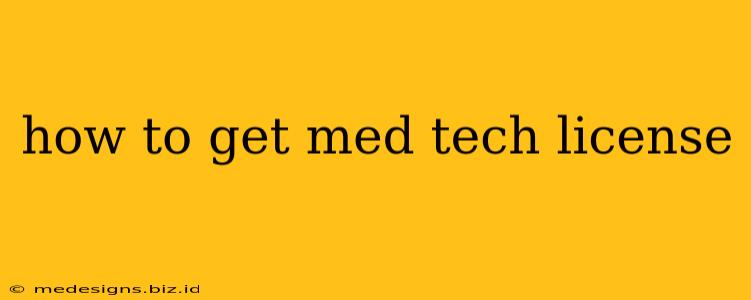Navigating the process of obtaining a medical technologist license can feel overwhelming, but with a structured approach, it becomes manageable. This comprehensive guide breaks down the steps involved, ensuring you're well-prepared for a successful application. We'll cover everything from educational requirements to examination processes and beyond.
Understanding Medical Technologist Licensing
Before diving into the specifics, it's crucial to understand that the requirements for a medical technologist license vary significantly depending on your location. Licensing is typically handled at the state or provincial level, not nationally. This means you'll need to research the specific regulations in your jurisdiction. Key aspects to research include:
-
Educational Requirements: Most jurisdictions mandate a minimum of a bachelor's degree in medical technology, clinical laboratory science, or a closely related field. Some may accept associate degrees with specific certifications, but this is less common. Accreditation of your program by an organization like the National Accrediting Agency for Clinical Laboratory Sciences (NAACLS) is often a prerequisite.
-
Examination Requirements: You'll almost certainly need to pass a national certification exam. The most common exam is the American Society for Clinical Pathology (ASCP) Board of Certification (BOC) exam. Passing this exam demonstrates competency and qualifies you for licensure in many states. Check your state's requirements to ensure the ASCP BOC exam, or an equivalent, is accepted.
-
Continuing Education: Maintaining your license often requires ongoing professional development through continuing education units (CEUs). These requirements vary by state, so keep an eye on renewal deadlines and necessary CEUs.
-
Background Checks: Be prepared for background checks as part of the licensing process. Criminal history and potentially even credit checks might be part of the vetting procedure.
Step-by-Step Guide to Obtaining Your Med Tech License
Here's a step-by-step guide to help you through the process:
1. Meet Educational Prerequisites
This is the foundational step. Thoroughly research the specific educational requirements in your state or province. Ensure your chosen program is accredited by a recognized agency. Focus on strong academic performance throughout your education.
2. Choose and Prepare for Certification Examination
After completing your education, register for the appropriate certification exam. The ASCP BOC exam is a frequently required exam, but verify this with your licensing board. Start preparing early – utilize study guides, practice questions, and review sessions to maximize your chances of success.
3. Apply for Licensure
Once you've passed your certification exam, you can begin the licensure application process. This usually involves submitting your application, transcripts, exam results, and possibly other documentation to the relevant state or provincial licensing board. The application process can take several weeks, even months, so apply well in advance.
4. Complete Background Checks & Other Requirements
Be prepared to undergo background checks and meet any additional requirements set by your licensing board. This might involve fingerprinting, providing references, or other specific documentation.
5. Maintain Your License
Once licensed, remember that your responsibilities don't end. Stay informed about continuing education requirements and renewal deadlines. Regularly check your licensing board's website for updates and maintain your professional development to uphold your license.
Overcoming Common Challenges
-
Finding Accredited Programs: Researching accredited programs can be time-consuming. Use online resources like the NAACLS website to locate accredited institutions in your area.
-
Exam Preparation: Passing the certification exam requires dedicated preparation. Create a study plan, utilize practice exams, and consider study groups to maximize your chances of success.
-
Navigating Bureaucracy: The licensing process involves navigating various forms and requirements. Be organized and keep meticulous records throughout the application process.
Remember: This information is for general guidance only. Always consult your state's or province's licensing board website for the most accurate and up-to-date information regarding medical technologist licensure. This ensures you're following the specific procedures and meeting all the requirements for your jurisdiction.
